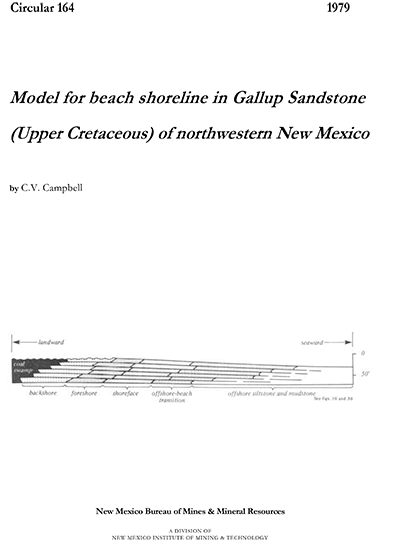
Circular 164 — Model for beach shoreline in Gallup Sandstone (Upper Cretaceous) of northwestern New Mexico
By C. V. Campbell, 1979, 32 pp., 1 table, 32 figs., 2 appendices.

A model stratigraphic cross section for beach deposits in the Gallup Sandstone (Upper Cretaceous) in the Ship Rock area of northwestern New Mexico was constructed for comparison with other ancient deposits as well as with modern beaches. This model provides a basis for predicting the location of petroleum reservoirs, evaluating source and seal relationships, determining volumes of both the reservoir and the aquifer providing the water drive, and predicting flow patterns within the reservoir.
Sandstone bodies interpreted as regressive beaches and transgressive offshore bars are well exposed in the Gallup Sandstone near Ship Rock in northwestern New Mexico. These outcrops trend perpendicular to the depositional strike and, along with information from core holes, provide data for constructing a model cross section of sandstone bodies across a beach shoreline. The model shows the distribution of beaches and their component facies as well as enclosing and associated facies. Both the model and its facies characteristics are presented as an example of an ancient shoreline that may be compared with other ancient and recent shorelines.
Both surface and subsurface procedures were used to compile the model. Outcrops of the Gallup Sandstone were correlated by walking selected bedding surfaces between measured sections. Subsurface correlations connect similar configurations on electric logs. In addition, as the bedding surfaces were walked, facies changes between them were mapped. On well logs, facies were identified by comparing log responses to cores and well samples and then interpreting facies in the framework established in the study of outcrops. Finally, the correlation and facies patterns were drawn on various datums; setting the landward tops of the offshore-bar sandstones as horizontal datums provides the most realistic reconstruction of the stratigraphic and facies relationships shown.
In the field, facies characteristics were recorded according to the principles of layering described by Campbell. Diagnostic characteristics include stratigraphic relationships, external geometry, internal bedding pattern, sedimentary structures, texture and composition, and fossil content. In the laboratory, 315 samples from 34 measured sections were slabbed and then examined with a binocular microscope. Variations in texture, composition, and sedimentary structures were further studied in thin sections of 70 samples selected as typical of the different facies. Also, combined sieve and pipette analyses of 35 samples representative of the different facies were run. In addition, 64 of the 126 samples that were examined for foraminifers, spores, and pollen contained fossils.
Across the Gallup shoreline, facies were identified and named by comparing them with facies in present nearshore environments. These environments and their facies responses are discussed in appendix 1. Similarities and differences between Gallup and facies are discussed here following a description of the geologic setting, the cross-sectional model, and the facies. Finally, applications to exploration and development of hydrocarbon reserves is discussed.
$5.75
Buy
Now
Also available as a free download.
Download
| File Name | Size | Last Modified |
|---|---|---|
| Circular-164.pdf | 1.38 MB | 01/11/2021 03:35:13 PM |



